Human Resource Management Report: Bendigo Bank Gender Inequality
VerifiedAdded on 2020/05/16
|12
|2843
|34
Report
AI Summary
This report, focusing on a case study of Bendigo and Adelaide Bank, critically analyzes the prevalent issue of gender inequality within the financial sector. It highlights the gender pay gap and the underrepresentation of women in senior management positions. The report delves into the differences between diversity management and equal employment opportunity, emphasizing the role of diversity management in enhancing organizational performance. It recommends initiatives such as diversity enlargement, performance management, cultural audits, and work-life balance to address these issues. The report also acknowledges the challenges in implementing diversity initiatives, such as resistance to change and communication barriers, and emphasizes the need for strategic, operational, and managerial approaches to create a more inclusive workplace. The analysis underscores the importance of training, transparency, and ongoing evaluation to promote gender equality and improve the overall organizational culture and productivity within the bank. The report concludes by advocating for comprehensive HRM practices to foster diversity and ensure equal opportunities for all employees.
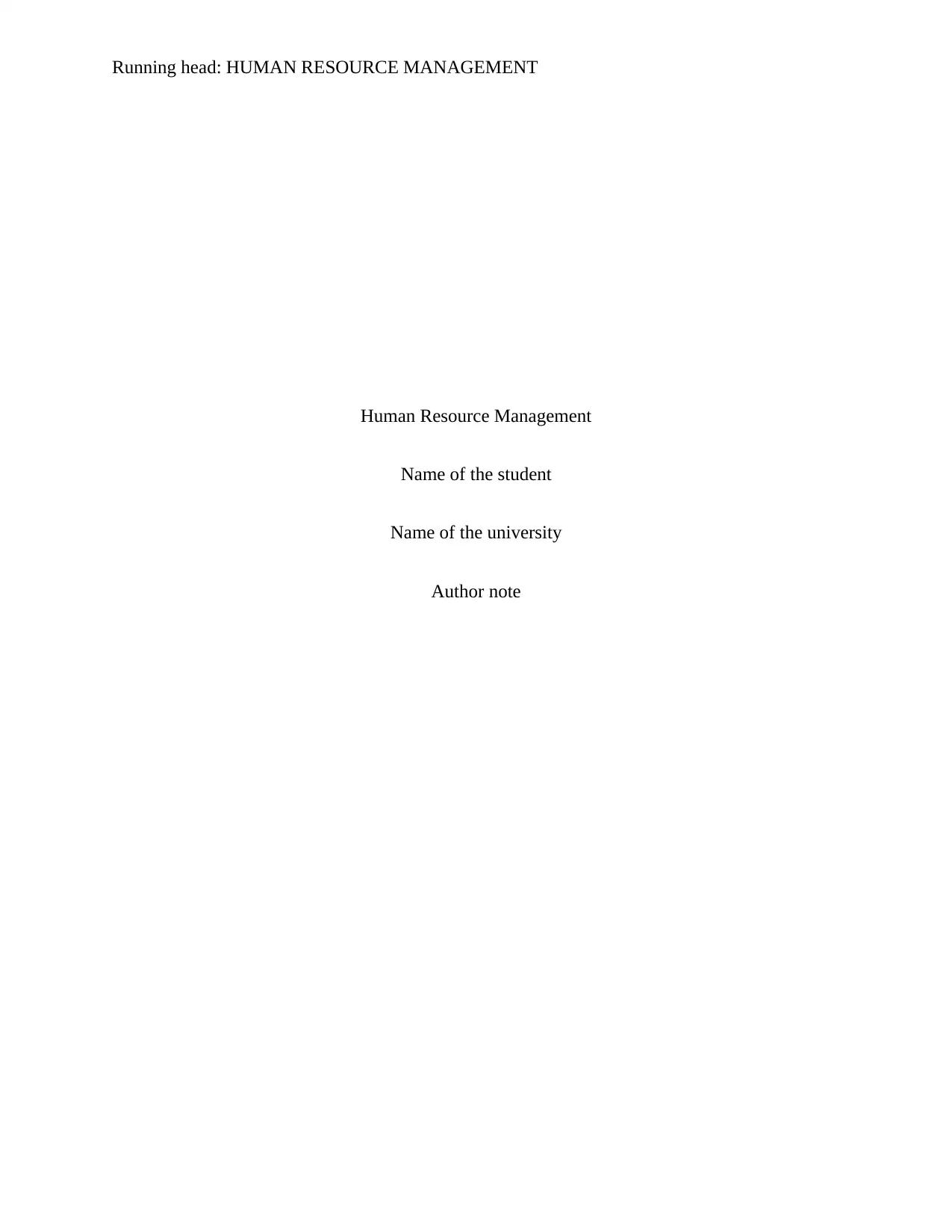
Running head: HUMAN RESOURCE MANAGEMENT
Human Resource Management
Name of the student
Name of the university
Author note
Human Resource Management
Name of the student
Name of the university
Author note
Paraphrase This Document
Need a fresh take? Get an instant paraphrase of this document with our AI Paraphraser
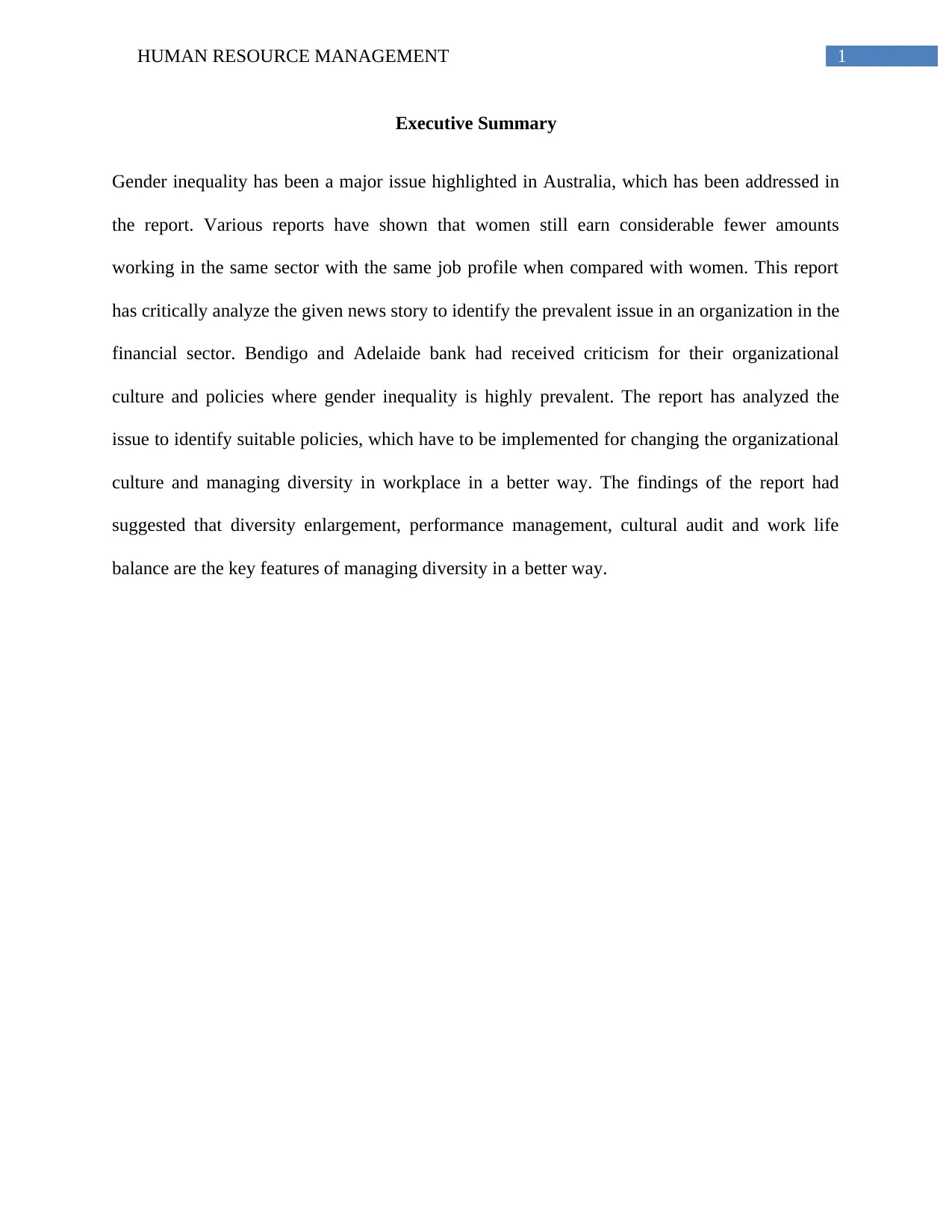
1HUMAN RESOURCE MANAGEMENT
Executive Summary
Gender inequality has been a major issue highlighted in Australia, which has been addressed in
the report. Various reports have shown that women still earn considerable fewer amounts
working in the same sector with the same job profile when compared with women. This report
has critically analyze the given news story to identify the prevalent issue in an organization in the
financial sector. Bendigo and Adelaide bank had received criticism for their organizational
culture and policies where gender inequality is highly prevalent. The report has analyzed the
issue to identify suitable policies, which have to be implemented for changing the organizational
culture and managing diversity in workplace in a better way. The findings of the report had
suggested that diversity enlargement, performance management, cultural audit and work life
balance are the key features of managing diversity in a better way.
Executive Summary
Gender inequality has been a major issue highlighted in Australia, which has been addressed in
the report. Various reports have shown that women still earn considerable fewer amounts
working in the same sector with the same job profile when compared with women. This report
has critically analyze the given news story to identify the prevalent issue in an organization in the
financial sector. Bendigo and Adelaide bank had received criticism for their organizational
culture and policies where gender inequality is highly prevalent. The report has analyzed the
issue to identify suitable policies, which have to be implemented for changing the organizational
culture and managing diversity in workplace in a better way. The findings of the report had
suggested that diversity enlargement, performance management, cultural audit and work life
balance are the key features of managing diversity in a better way.
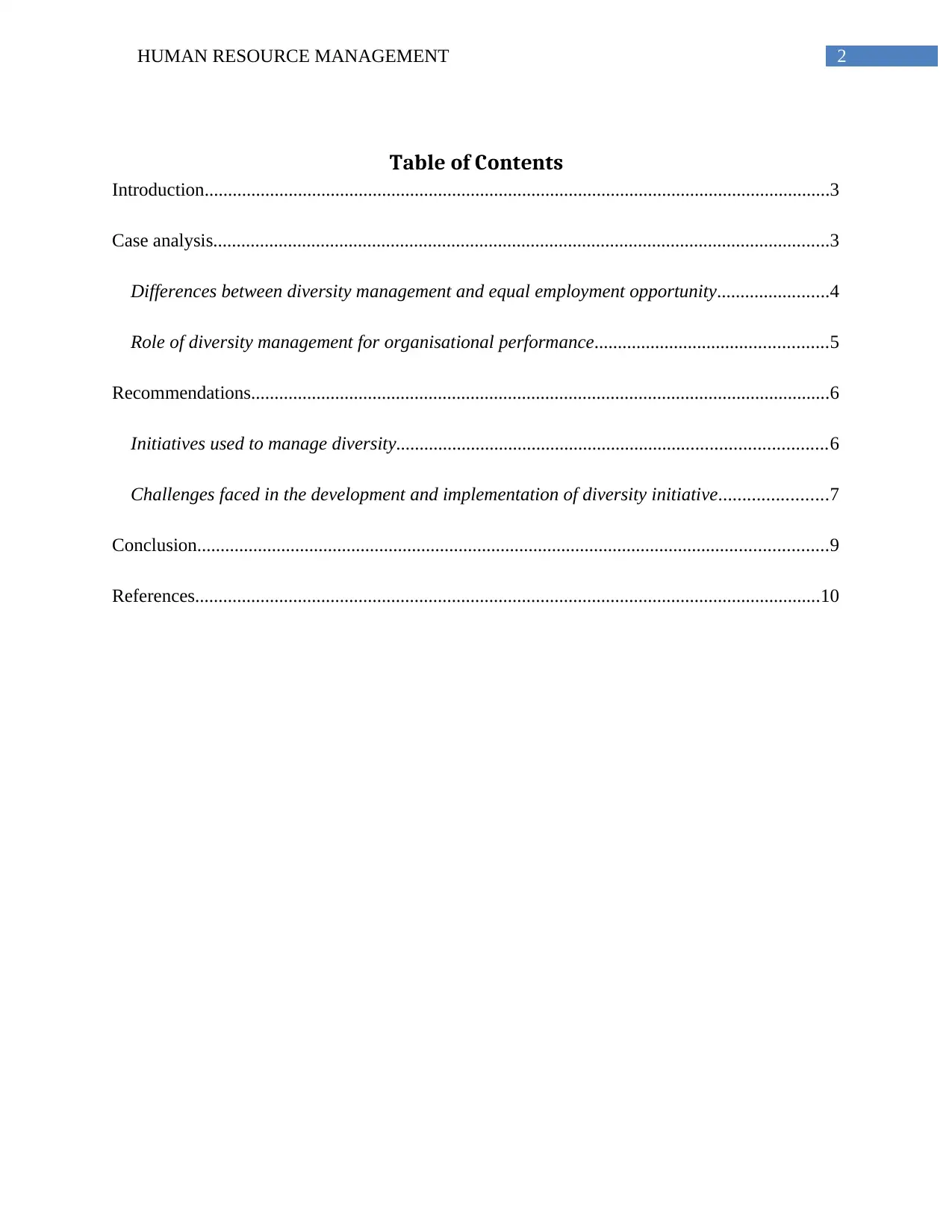
2HUMAN RESOURCE MANAGEMENT
Table of Contents
Introduction......................................................................................................................................3
Case analysis....................................................................................................................................3
Differences between diversity management and equal employment opportunity........................4
Role of diversity management for organisational performance..................................................5
Recommendations............................................................................................................................6
Initiatives used to manage diversity............................................................................................6
Challenges faced in the development and implementation of diversity initiative.......................7
Conclusion.......................................................................................................................................9
References......................................................................................................................................10
Table of Contents
Introduction......................................................................................................................................3
Case analysis....................................................................................................................................3
Differences between diversity management and equal employment opportunity........................4
Role of diversity management for organisational performance..................................................5
Recommendations............................................................................................................................6
Initiatives used to manage diversity............................................................................................6
Challenges faced in the development and implementation of diversity initiative.......................7
Conclusion.......................................................................................................................................9
References......................................................................................................................................10
⊘ This is a preview!⊘
Do you want full access?
Subscribe today to unlock all pages.

Trusted by 1+ million students worldwide
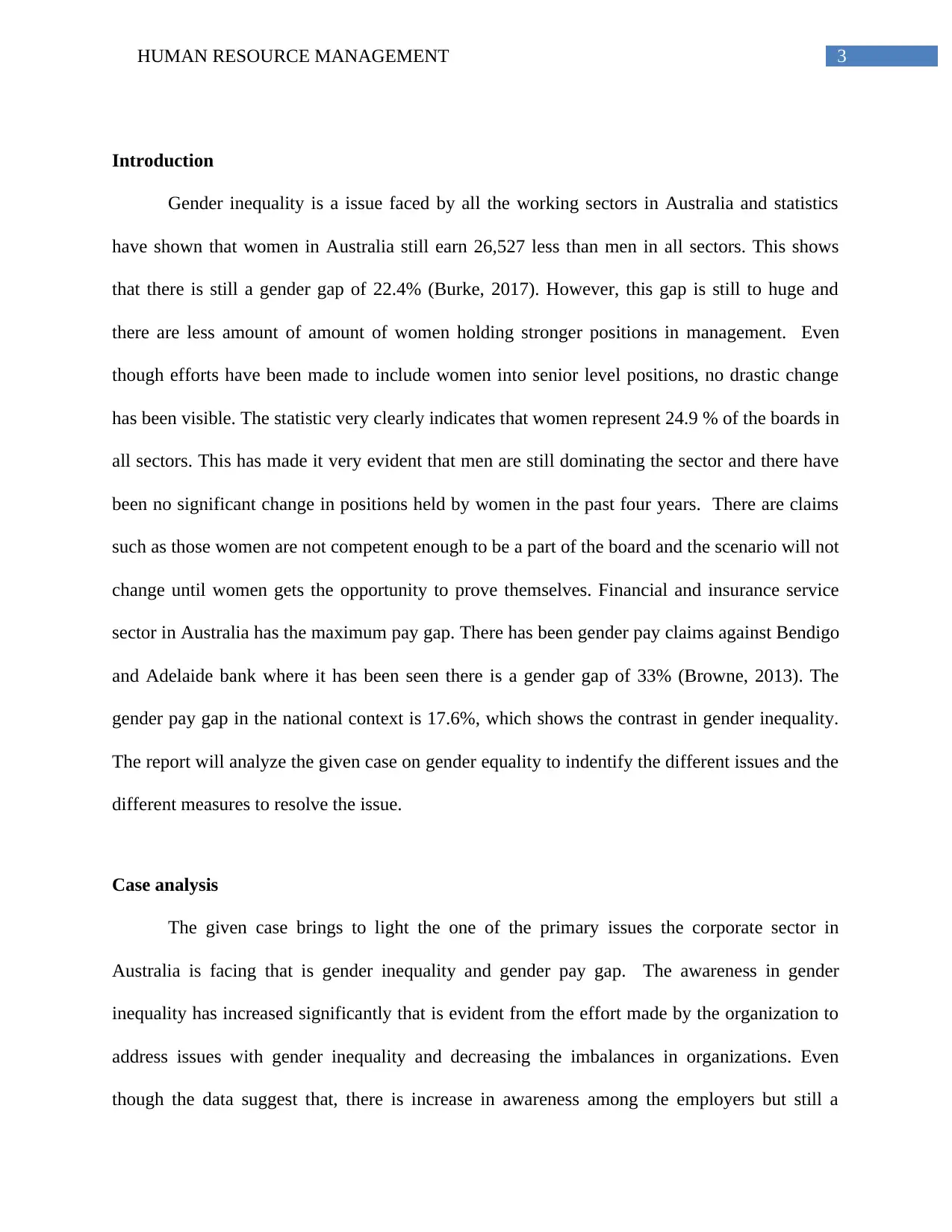
3HUMAN RESOURCE MANAGEMENT
Introduction
Gender inequality is a issue faced by all the working sectors in Australia and statistics
have shown that women in Australia still earn 26,527 less than men in all sectors. This shows
that there is still a gender gap of 22.4% (Burke, 2017). However, this gap is still to huge and
there are less amount of amount of women holding stronger positions in management. Even
though efforts have been made to include women into senior level positions, no drastic change
has been visible. The statistic very clearly indicates that women represent 24.9 % of the boards in
all sectors. This has made it very evident that men are still dominating the sector and there have
been no significant change in positions held by women in the past four years. There are claims
such as those women are not competent enough to be a part of the board and the scenario will not
change until women gets the opportunity to prove themselves. Financial and insurance service
sector in Australia has the maximum pay gap. There has been gender pay claims against Bendigo
and Adelaide bank where it has been seen there is a gender gap of 33% (Browne, 2013). The
gender pay gap in the national context is 17.6%, which shows the contrast in gender inequality.
The report will analyze the given case on gender equality to indentify the different issues and the
different measures to resolve the issue.
Case analysis
The given case brings to light the one of the primary issues the corporate sector in
Australia is facing that is gender inequality and gender pay gap. The awareness in gender
inequality has increased significantly that is evident from the effort made by the organization to
address issues with gender inequality and decreasing the imbalances in organizations. Even
though the data suggest that, there is increase in awareness among the employers but still a
Introduction
Gender inequality is a issue faced by all the working sectors in Australia and statistics
have shown that women in Australia still earn 26,527 less than men in all sectors. This shows
that there is still a gender gap of 22.4% (Burke, 2017). However, this gap is still to huge and
there are less amount of amount of women holding stronger positions in management. Even
though efforts have been made to include women into senior level positions, no drastic change
has been visible. The statistic very clearly indicates that women represent 24.9 % of the boards in
all sectors. This has made it very evident that men are still dominating the sector and there have
been no significant change in positions held by women in the past four years. There are claims
such as those women are not competent enough to be a part of the board and the scenario will not
change until women gets the opportunity to prove themselves. Financial and insurance service
sector in Australia has the maximum pay gap. There has been gender pay claims against Bendigo
and Adelaide bank where it has been seen there is a gender gap of 33% (Browne, 2013). The
gender pay gap in the national context is 17.6%, which shows the contrast in gender inequality.
The report will analyze the given case on gender equality to indentify the different issues and the
different measures to resolve the issue.
Case analysis
The given case brings to light the one of the primary issues the corporate sector in
Australia is facing that is gender inequality and gender pay gap. The awareness in gender
inequality has increased significantly that is evident from the effort made by the organization to
address issues with gender inequality and decreasing the imbalances in organizations. Even
though the data suggest that, there is increase in awareness among the employers but still a
Paraphrase This Document
Need a fresh take? Get an instant paraphrase of this document with our AI Paraphraser
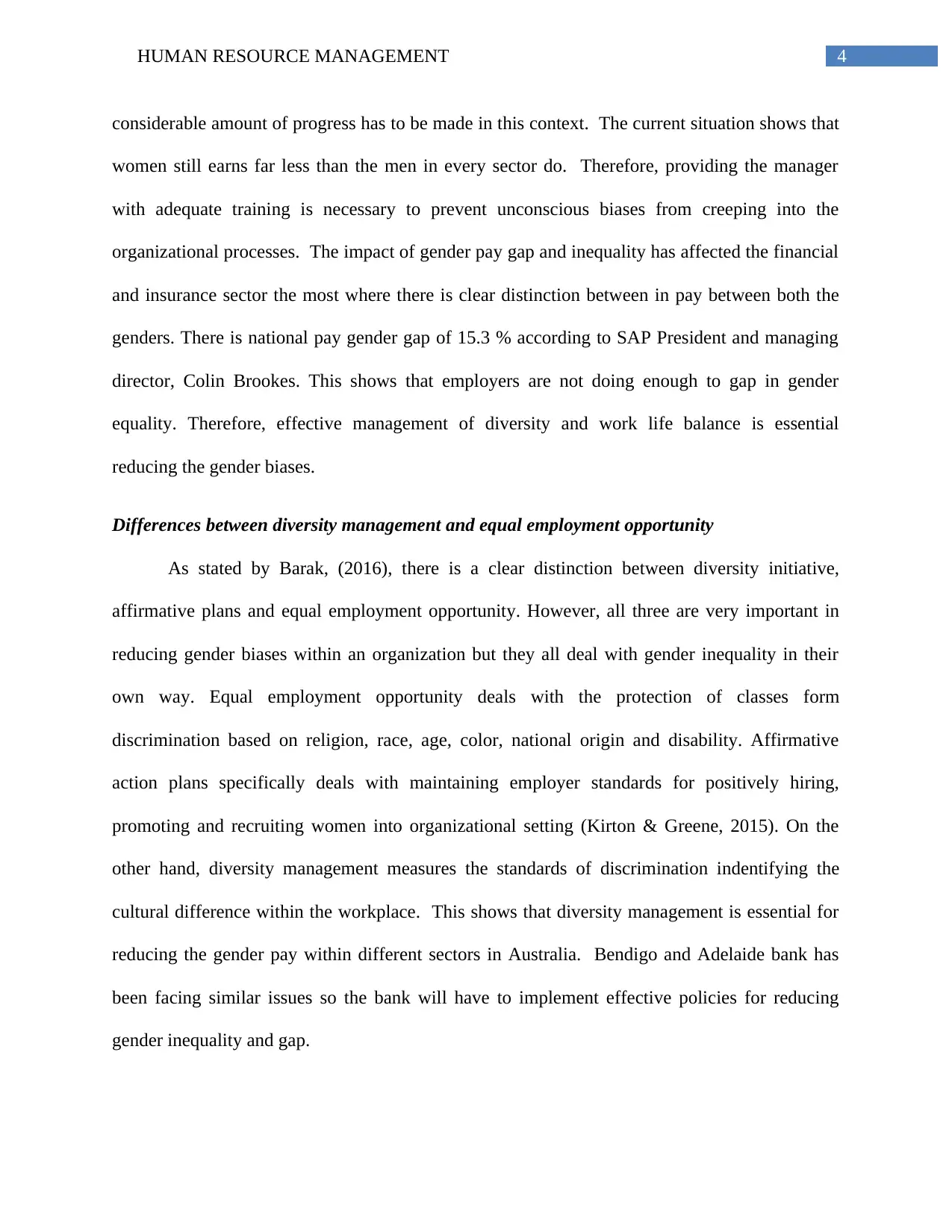
4HUMAN RESOURCE MANAGEMENT
considerable amount of progress has to be made in this context. The current situation shows that
women still earns far less than the men in every sector do. Therefore, providing the manager
with adequate training is necessary to prevent unconscious biases from creeping into the
organizational processes. The impact of gender pay gap and inequality has affected the financial
and insurance sector the most where there is clear distinction between in pay between both the
genders. There is national pay gender gap of 15.3 % according to SAP President and managing
director, Colin Brookes. This shows that employers are not doing enough to gap in gender
equality. Therefore, effective management of diversity and work life balance is essential
reducing the gender biases.
Differences between diversity management and equal employment opportunity
As stated by Barak, (2016), there is a clear distinction between diversity initiative,
affirmative plans and equal employment opportunity. However, all three are very important in
reducing gender biases within an organization but they all deal with gender inequality in their
own way. Equal employment opportunity deals with the protection of classes form
discrimination based on religion, race, age, color, national origin and disability. Affirmative
action plans specifically deals with maintaining employer standards for positively hiring,
promoting and recruiting women into organizational setting (Kirton & Greene, 2015). On the
other hand, diversity management measures the standards of discrimination indentifying the
cultural difference within the workplace. This shows that diversity management is essential for
reducing the gender pay within different sectors in Australia. Bendigo and Adelaide bank has
been facing similar issues so the bank will have to implement effective policies for reducing
gender inequality and gap.
considerable amount of progress has to be made in this context. The current situation shows that
women still earns far less than the men in every sector do. Therefore, providing the manager
with adequate training is necessary to prevent unconscious biases from creeping into the
organizational processes. The impact of gender pay gap and inequality has affected the financial
and insurance sector the most where there is clear distinction between in pay between both the
genders. There is national pay gender gap of 15.3 % according to SAP President and managing
director, Colin Brookes. This shows that employers are not doing enough to gap in gender
equality. Therefore, effective management of diversity and work life balance is essential
reducing the gender biases.
Differences between diversity management and equal employment opportunity
As stated by Barak, (2016), there is a clear distinction between diversity initiative,
affirmative plans and equal employment opportunity. However, all three are very important in
reducing gender biases within an organization but they all deal with gender inequality in their
own way. Equal employment opportunity deals with the protection of classes form
discrimination based on religion, race, age, color, national origin and disability. Affirmative
action plans specifically deals with maintaining employer standards for positively hiring,
promoting and recruiting women into organizational setting (Kirton & Greene, 2015). On the
other hand, diversity management measures the standards of discrimination indentifying the
cultural difference within the workplace. This shows that diversity management is essential for
reducing the gender pay within different sectors in Australia. Bendigo and Adelaide bank has
been facing similar issues so the bank will have to implement effective policies for reducing
gender inequality and gap.
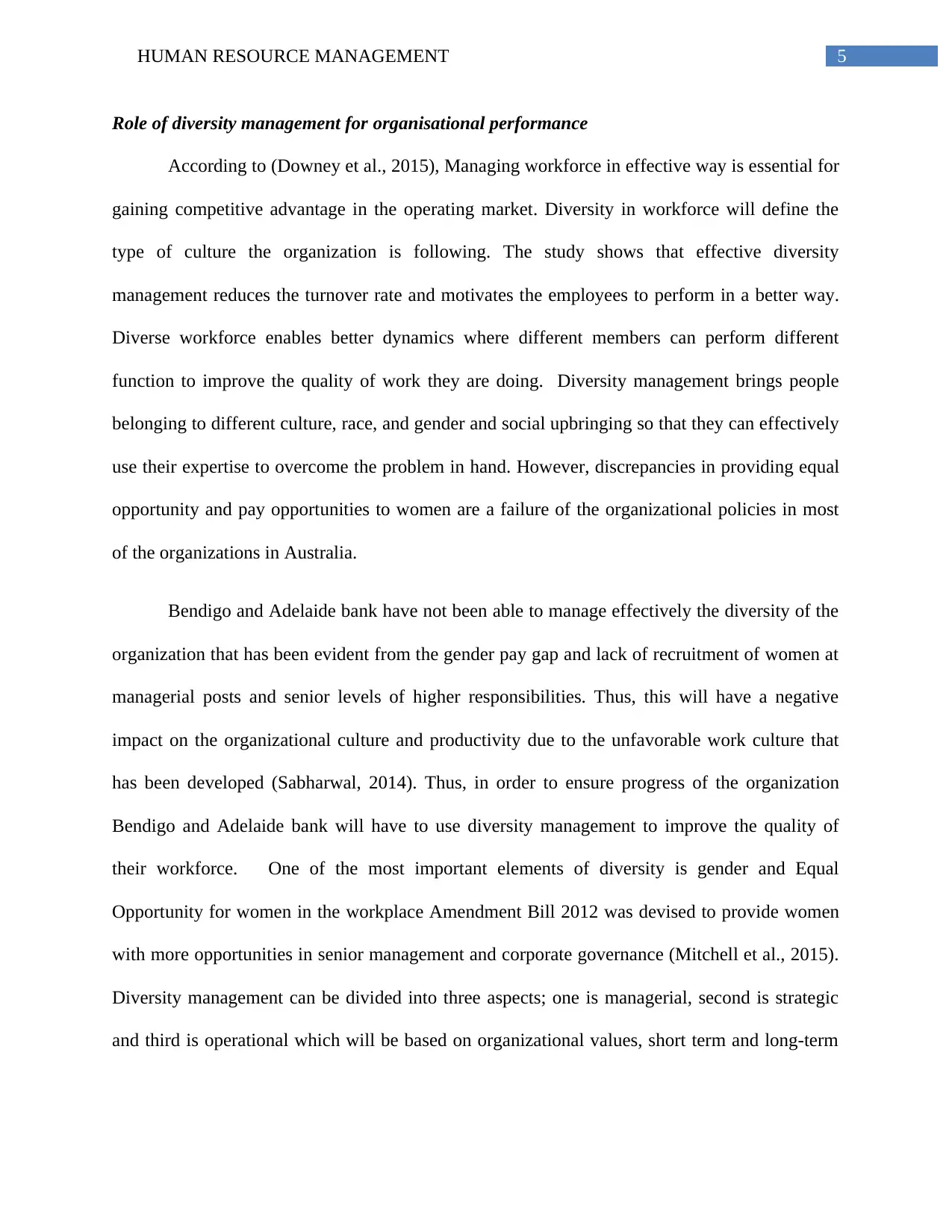
5HUMAN RESOURCE MANAGEMENT
Role of diversity management for organisational performance
According to (Downey et al., 2015), Managing workforce in effective way is essential for
gaining competitive advantage in the operating market. Diversity in workforce will define the
type of culture the organization is following. The study shows that effective diversity
management reduces the turnover rate and motivates the employees to perform in a better way.
Diverse workforce enables better dynamics where different members can perform different
function to improve the quality of work they are doing. Diversity management brings people
belonging to different culture, race, and gender and social upbringing so that they can effectively
use their expertise to overcome the problem in hand. However, discrepancies in providing equal
opportunity and pay opportunities to women are a failure of the organizational policies in most
of the organizations in Australia.
Bendigo and Adelaide bank have not been able to manage effectively the diversity of the
organization that has been evident from the gender pay gap and lack of recruitment of women at
managerial posts and senior levels of higher responsibilities. Thus, this will have a negative
impact on the organizational culture and productivity due to the unfavorable work culture that
has been developed (Sabharwal, 2014). Thus, in order to ensure progress of the organization
Bendigo and Adelaide bank will have to use diversity management to improve the quality of
their workforce. One of the most important elements of diversity is gender and Equal
Opportunity for women in the workplace Amendment Bill 2012 was devised to provide women
with more opportunities in senior management and corporate governance (Mitchell et al., 2015).
Diversity management can be divided into three aspects; one is managerial, second is strategic
and third is operational which will be based on organizational values, short term and long-term
Role of diversity management for organisational performance
According to (Downey et al., 2015), Managing workforce in effective way is essential for
gaining competitive advantage in the operating market. Diversity in workforce will define the
type of culture the organization is following. The study shows that effective diversity
management reduces the turnover rate and motivates the employees to perform in a better way.
Diverse workforce enables better dynamics where different members can perform different
function to improve the quality of work they are doing. Diversity management brings people
belonging to different culture, race, and gender and social upbringing so that they can effectively
use their expertise to overcome the problem in hand. However, discrepancies in providing equal
opportunity and pay opportunities to women are a failure of the organizational policies in most
of the organizations in Australia.
Bendigo and Adelaide bank have not been able to manage effectively the diversity of the
organization that has been evident from the gender pay gap and lack of recruitment of women at
managerial posts and senior levels of higher responsibilities. Thus, this will have a negative
impact on the organizational culture and productivity due to the unfavorable work culture that
has been developed (Sabharwal, 2014). Thus, in order to ensure progress of the organization
Bendigo and Adelaide bank will have to use diversity management to improve the quality of
their workforce. One of the most important elements of diversity is gender and Equal
Opportunity for women in the workplace Amendment Bill 2012 was devised to provide women
with more opportunities in senior management and corporate governance (Mitchell et al., 2015).
Diversity management can be divided into three aspects; one is managerial, second is strategic
and third is operational which will be based on organizational values, short term and long-term
⊘ This is a preview!⊘
Do you want full access?
Subscribe today to unlock all pages.

Trusted by 1+ million students worldwide
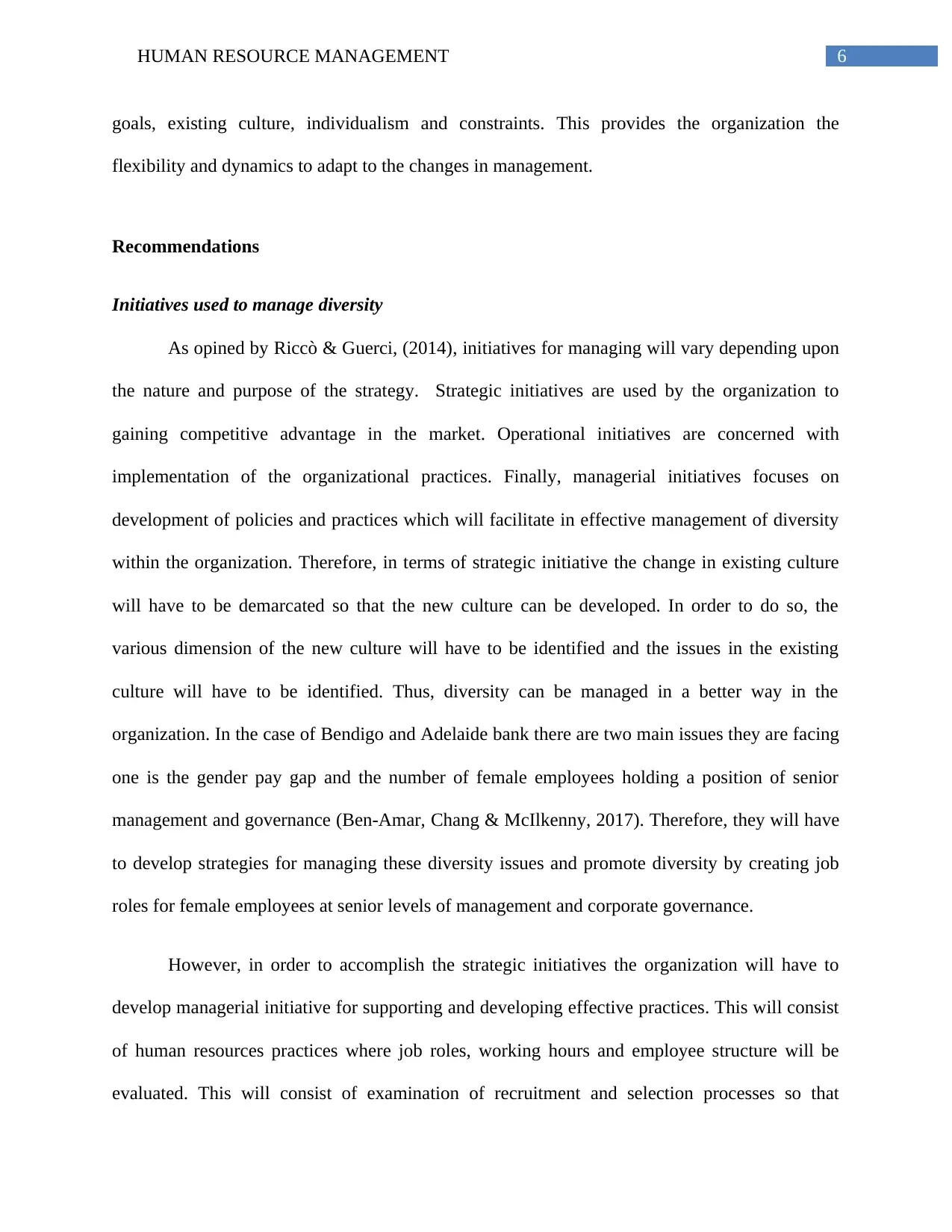
6HUMAN RESOURCE MANAGEMENT
goals, existing culture, individualism and constraints. This provides the organization the
flexibility and dynamics to adapt to the changes in management.
Recommendations
Initiatives used to manage diversity
As opined by Riccò & Guerci, (2014), initiatives for managing will vary depending upon
the nature and purpose of the strategy. Strategic initiatives are used by the organization to
gaining competitive advantage in the market. Operational initiatives are concerned with
implementation of the organizational practices. Finally, managerial initiatives focuses on
development of policies and practices which will facilitate in effective management of diversity
within the organization. Therefore, in terms of strategic initiative the change in existing culture
will have to be demarcated so that the new culture can be developed. In order to do so, the
various dimension of the new culture will have to be identified and the issues in the existing
culture will have to be identified. Thus, diversity can be managed in a better way in the
organization. In the case of Bendigo and Adelaide bank there are two main issues they are facing
one is the gender pay gap and the number of female employees holding a position of senior
management and governance (Ben-Amar, Chang & McIlkenny, 2017). Therefore, they will have
to develop strategies for managing these diversity issues and promote diversity by creating job
roles for female employees at senior levels of management and corporate governance.
However, in order to accomplish the strategic initiatives the organization will have to
develop managerial initiative for supporting and developing effective practices. This will consist
of human resources practices where job roles, working hours and employee structure will be
evaluated. This will consist of examination of recruitment and selection processes so that
goals, existing culture, individualism and constraints. This provides the organization the
flexibility and dynamics to adapt to the changes in management.
Recommendations
Initiatives used to manage diversity
As opined by Riccò & Guerci, (2014), initiatives for managing will vary depending upon
the nature and purpose of the strategy. Strategic initiatives are used by the organization to
gaining competitive advantage in the market. Operational initiatives are concerned with
implementation of the organizational practices. Finally, managerial initiatives focuses on
development of policies and practices which will facilitate in effective management of diversity
within the organization. Therefore, in terms of strategic initiative the change in existing culture
will have to be demarcated so that the new culture can be developed. In order to do so, the
various dimension of the new culture will have to be identified and the issues in the existing
culture will have to be identified. Thus, diversity can be managed in a better way in the
organization. In the case of Bendigo and Adelaide bank there are two main issues they are facing
one is the gender pay gap and the number of female employees holding a position of senior
management and governance (Ben-Amar, Chang & McIlkenny, 2017). Therefore, they will have
to develop strategies for managing these diversity issues and promote diversity by creating job
roles for female employees at senior levels of management and corporate governance.
However, in order to accomplish the strategic initiatives the organization will have to
develop managerial initiative for supporting and developing effective practices. This will consist
of human resources practices where job roles, working hours and employee structure will be
evaluated. This will consist of examination of recruitment and selection processes so that
Paraphrase This Document
Need a fresh take? Get an instant paraphrase of this document with our AI Paraphraser
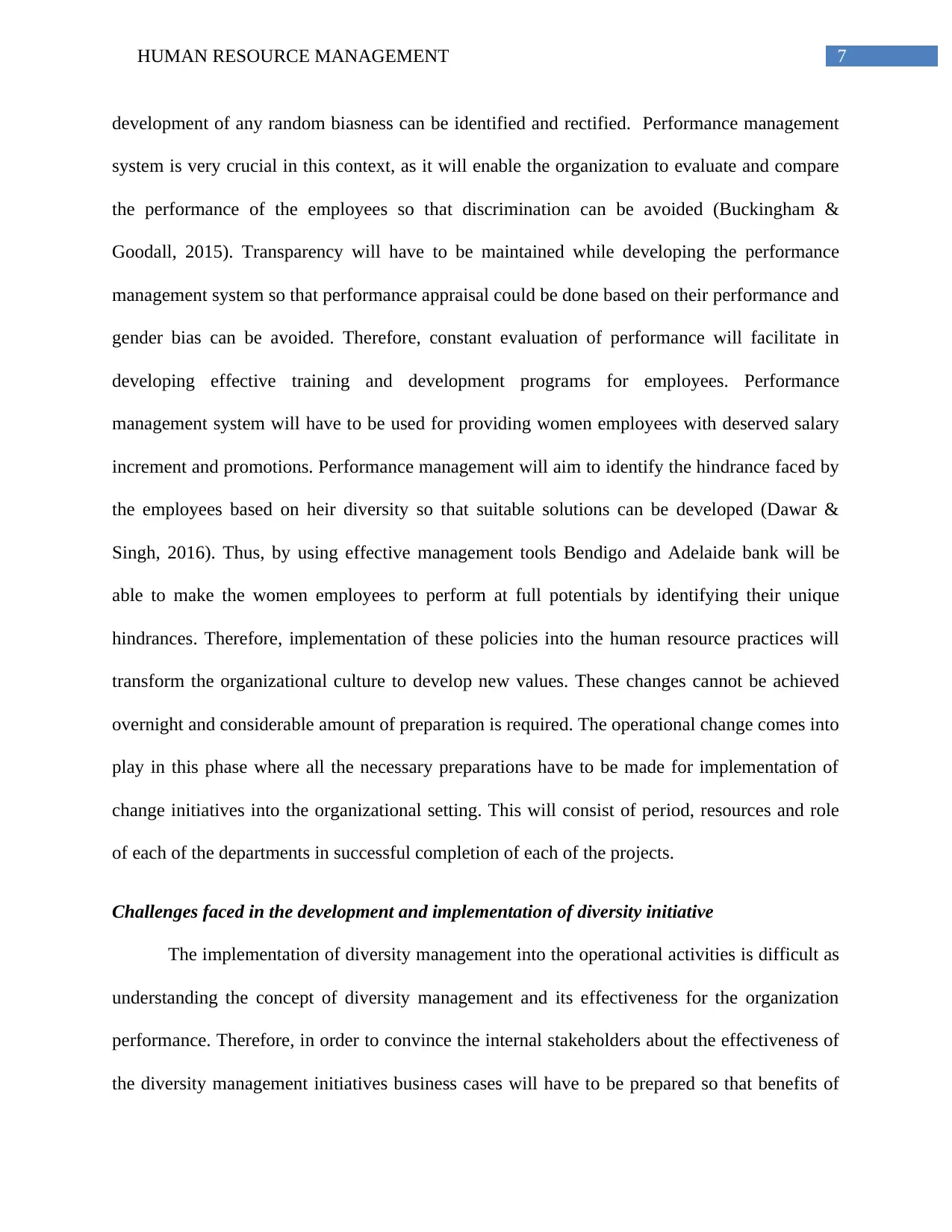
7HUMAN RESOURCE MANAGEMENT
development of any random biasness can be identified and rectified. Performance management
system is very crucial in this context, as it will enable the organization to evaluate and compare
the performance of the employees so that discrimination can be avoided (Buckingham &
Goodall, 2015). Transparency will have to be maintained while developing the performance
management system so that performance appraisal could be done based on their performance and
gender bias can be avoided. Therefore, constant evaluation of performance will facilitate in
developing effective training and development programs for employees. Performance
management system will have to be used for providing women employees with deserved salary
increment and promotions. Performance management will aim to identify the hindrance faced by
the employees based on heir diversity so that suitable solutions can be developed (Dawar &
Singh, 2016). Thus, by using effective management tools Bendigo and Adelaide bank will be
able to make the women employees to perform at full potentials by identifying their unique
hindrances. Therefore, implementation of these policies into the human resource practices will
transform the organizational culture to develop new values. These changes cannot be achieved
overnight and considerable amount of preparation is required. The operational change comes into
play in this phase where all the necessary preparations have to be made for implementation of
change initiatives into the organizational setting. This will consist of period, resources and role
of each of the departments in successful completion of each of the projects.
Challenges faced in the development and implementation of diversity initiative
The implementation of diversity management into the operational activities is difficult as
understanding the concept of diversity management and its effectiveness for the organization
performance. Therefore, in order to convince the internal stakeholders about the effectiveness of
the diversity management initiatives business cases will have to be prepared so that benefits of
development of any random biasness can be identified and rectified. Performance management
system is very crucial in this context, as it will enable the organization to evaluate and compare
the performance of the employees so that discrimination can be avoided (Buckingham &
Goodall, 2015). Transparency will have to be maintained while developing the performance
management system so that performance appraisal could be done based on their performance and
gender bias can be avoided. Therefore, constant evaluation of performance will facilitate in
developing effective training and development programs for employees. Performance
management system will have to be used for providing women employees with deserved salary
increment and promotions. Performance management will aim to identify the hindrance faced by
the employees based on heir diversity so that suitable solutions can be developed (Dawar &
Singh, 2016). Thus, by using effective management tools Bendigo and Adelaide bank will be
able to make the women employees to perform at full potentials by identifying their unique
hindrances. Therefore, implementation of these policies into the human resource practices will
transform the organizational culture to develop new values. These changes cannot be achieved
overnight and considerable amount of preparation is required. The operational change comes into
play in this phase where all the necessary preparations have to be made for implementation of
change initiatives into the organizational setting. This will consist of period, resources and role
of each of the departments in successful completion of each of the projects.
Challenges faced in the development and implementation of diversity initiative
The implementation of diversity management into the operational activities is difficult as
understanding the concept of diversity management and its effectiveness for the organization
performance. Therefore, in order to convince the internal stakeholders about the effectiveness of
the diversity management initiatives business cases will have to be prepared so that benefits of
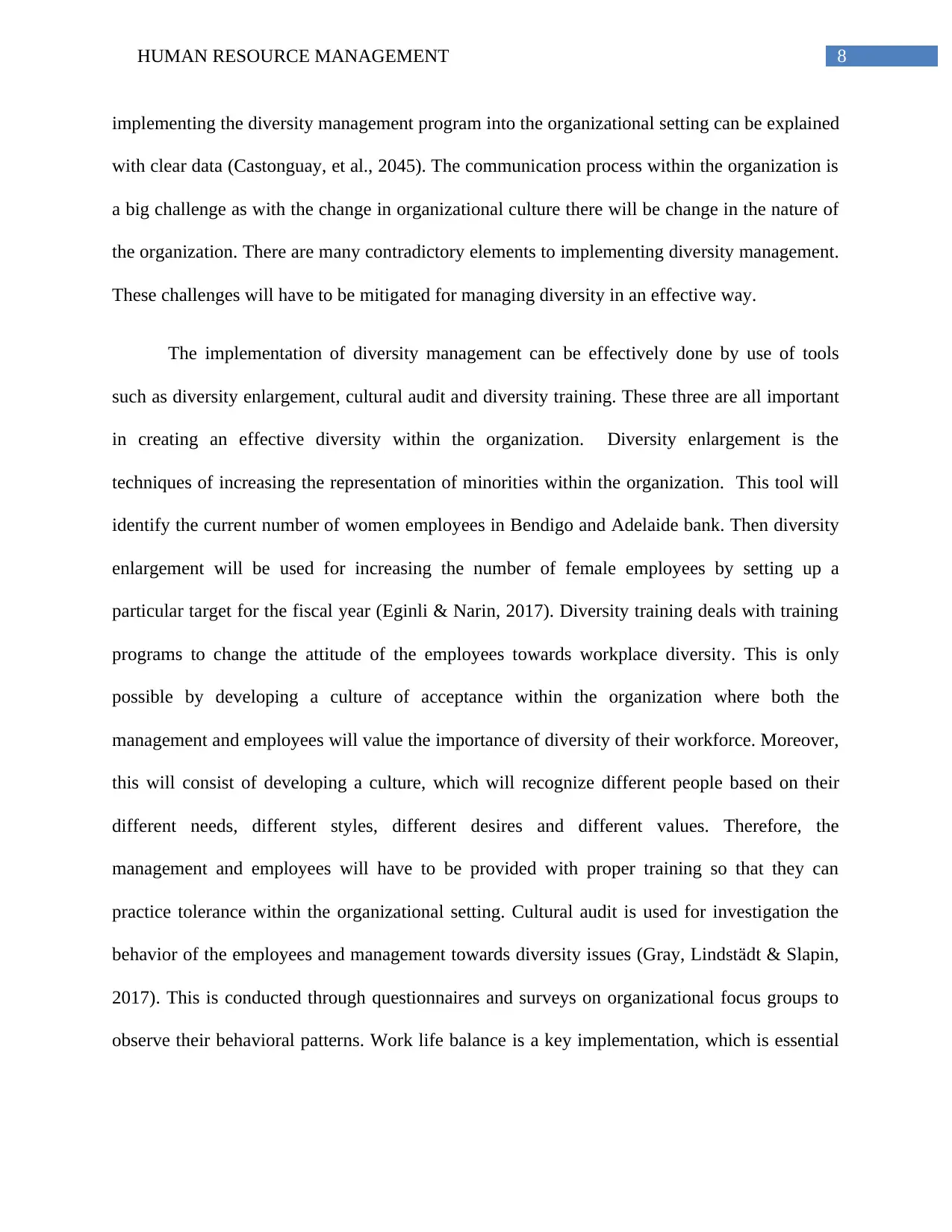
8HUMAN RESOURCE MANAGEMENT
implementing the diversity management program into the organizational setting can be explained
with clear data (Castonguay, et al., 2045). The communication process within the organization is
a big challenge as with the change in organizational culture there will be change in the nature of
the organization. There are many contradictory elements to implementing diversity management.
These challenges will have to be mitigated for managing diversity in an effective way.
The implementation of diversity management can be effectively done by use of tools
such as diversity enlargement, cultural audit and diversity training. These three are all important
in creating an effective diversity within the organization. Diversity enlargement is the
techniques of increasing the representation of minorities within the organization. This tool will
identify the current number of women employees in Bendigo and Adelaide bank. Then diversity
enlargement will be used for increasing the number of female employees by setting up a
particular target for the fiscal year (Eginli & Narin, 2017). Diversity training deals with training
programs to change the attitude of the employees towards workplace diversity. This is only
possible by developing a culture of acceptance within the organization where both the
management and employees will value the importance of diversity of their workforce. Moreover,
this will consist of developing a culture, which will recognize different people based on their
different needs, different styles, different desires and different values. Therefore, the
management and employees will have to be provided with proper training so that they can
practice tolerance within the organizational setting. Cultural audit is used for investigation the
behavior of the employees and management towards diversity issues (Gray, Lindstädt & Slapin,
2017). This is conducted through questionnaires and surveys on organizational focus groups to
observe their behavioral patterns. Work life balance is a key implementation, which is essential
implementing the diversity management program into the organizational setting can be explained
with clear data (Castonguay, et al., 2045). The communication process within the organization is
a big challenge as with the change in organizational culture there will be change in the nature of
the organization. There are many contradictory elements to implementing diversity management.
These challenges will have to be mitigated for managing diversity in an effective way.
The implementation of diversity management can be effectively done by use of tools
such as diversity enlargement, cultural audit and diversity training. These three are all important
in creating an effective diversity within the organization. Diversity enlargement is the
techniques of increasing the representation of minorities within the organization. This tool will
identify the current number of women employees in Bendigo and Adelaide bank. Then diversity
enlargement will be used for increasing the number of female employees by setting up a
particular target for the fiscal year (Eginli & Narin, 2017). Diversity training deals with training
programs to change the attitude of the employees towards workplace diversity. This is only
possible by developing a culture of acceptance within the organization where both the
management and employees will value the importance of diversity of their workforce. Moreover,
this will consist of developing a culture, which will recognize different people based on their
different needs, different styles, different desires and different values. Therefore, the
management and employees will have to be provided with proper training so that they can
practice tolerance within the organizational setting. Cultural audit is used for investigation the
behavior of the employees and management towards diversity issues (Gray, Lindstädt & Slapin,
2017). This is conducted through questionnaires and surveys on organizational focus groups to
observe their behavioral patterns. Work life balance is a key implementation, which is essential
⊘ This is a preview!⊘
Do you want full access?
Subscribe today to unlock all pages.

Trusted by 1+ million students worldwide
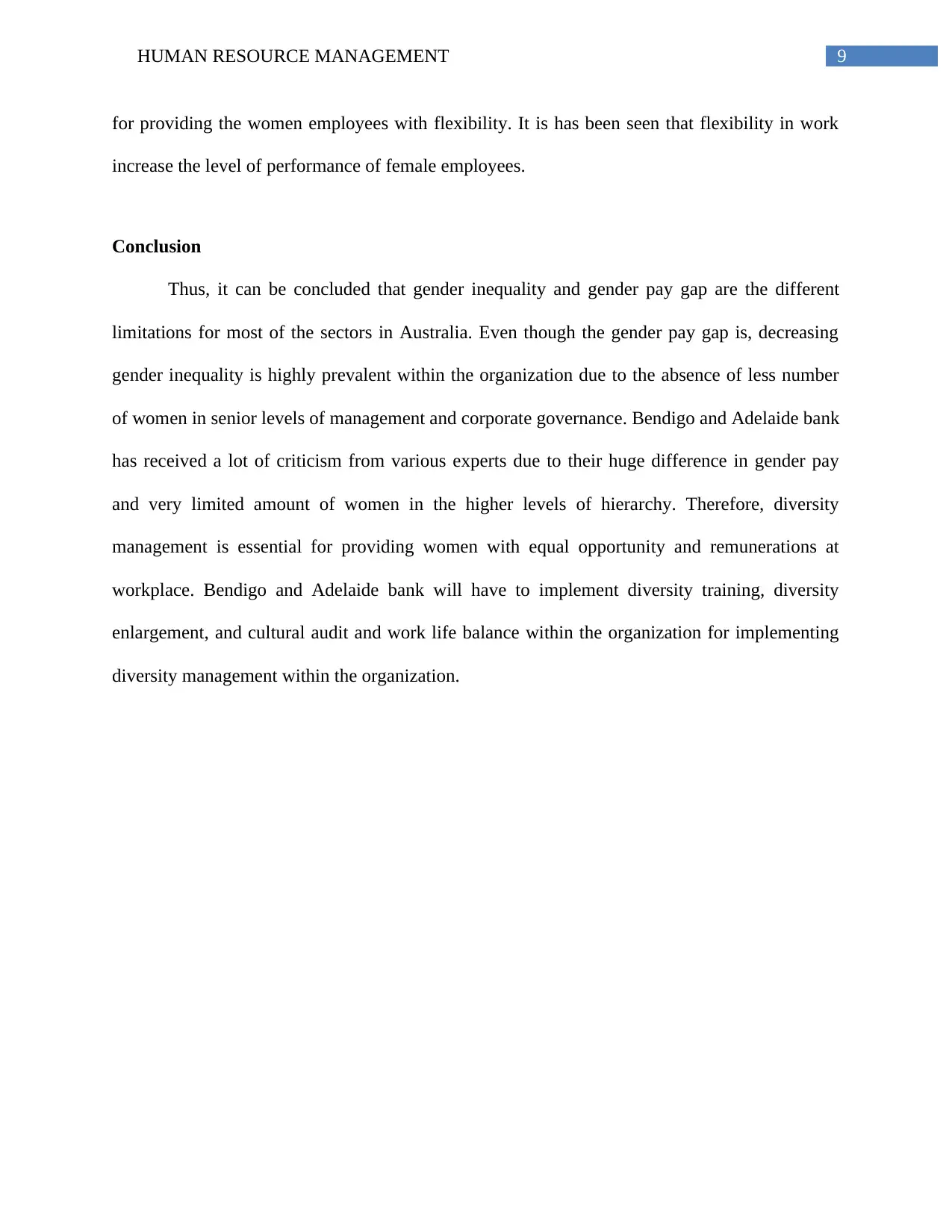
9HUMAN RESOURCE MANAGEMENT
for providing the women employees with flexibility. It is has been seen that flexibility in work
increase the level of performance of female employees.
Conclusion
Thus, it can be concluded that gender inequality and gender pay gap are the different
limitations for most of the sectors in Australia. Even though the gender pay gap is, decreasing
gender inequality is highly prevalent within the organization due to the absence of less number
of women in senior levels of management and corporate governance. Bendigo and Adelaide bank
has received a lot of criticism from various experts due to their huge difference in gender pay
and very limited amount of women in the higher levels of hierarchy. Therefore, diversity
management is essential for providing women with equal opportunity and remunerations at
workplace. Bendigo and Adelaide bank will have to implement diversity training, diversity
enlargement, and cultural audit and work life balance within the organization for implementing
diversity management within the organization.
for providing the women employees with flexibility. It is has been seen that flexibility in work
increase the level of performance of female employees.
Conclusion
Thus, it can be concluded that gender inequality and gender pay gap are the different
limitations for most of the sectors in Australia. Even though the gender pay gap is, decreasing
gender inequality is highly prevalent within the organization due to the absence of less number
of women in senior levels of management and corporate governance. Bendigo and Adelaide bank
has received a lot of criticism from various experts due to their huge difference in gender pay
and very limited amount of women in the higher levels of hierarchy. Therefore, diversity
management is essential for providing women with equal opportunity and remunerations at
workplace. Bendigo and Adelaide bank will have to implement diversity training, diversity
enlargement, and cultural audit and work life balance within the organization for implementing
diversity management within the organization.
Paraphrase This Document
Need a fresh take? Get an instant paraphrase of this document with our AI Paraphraser
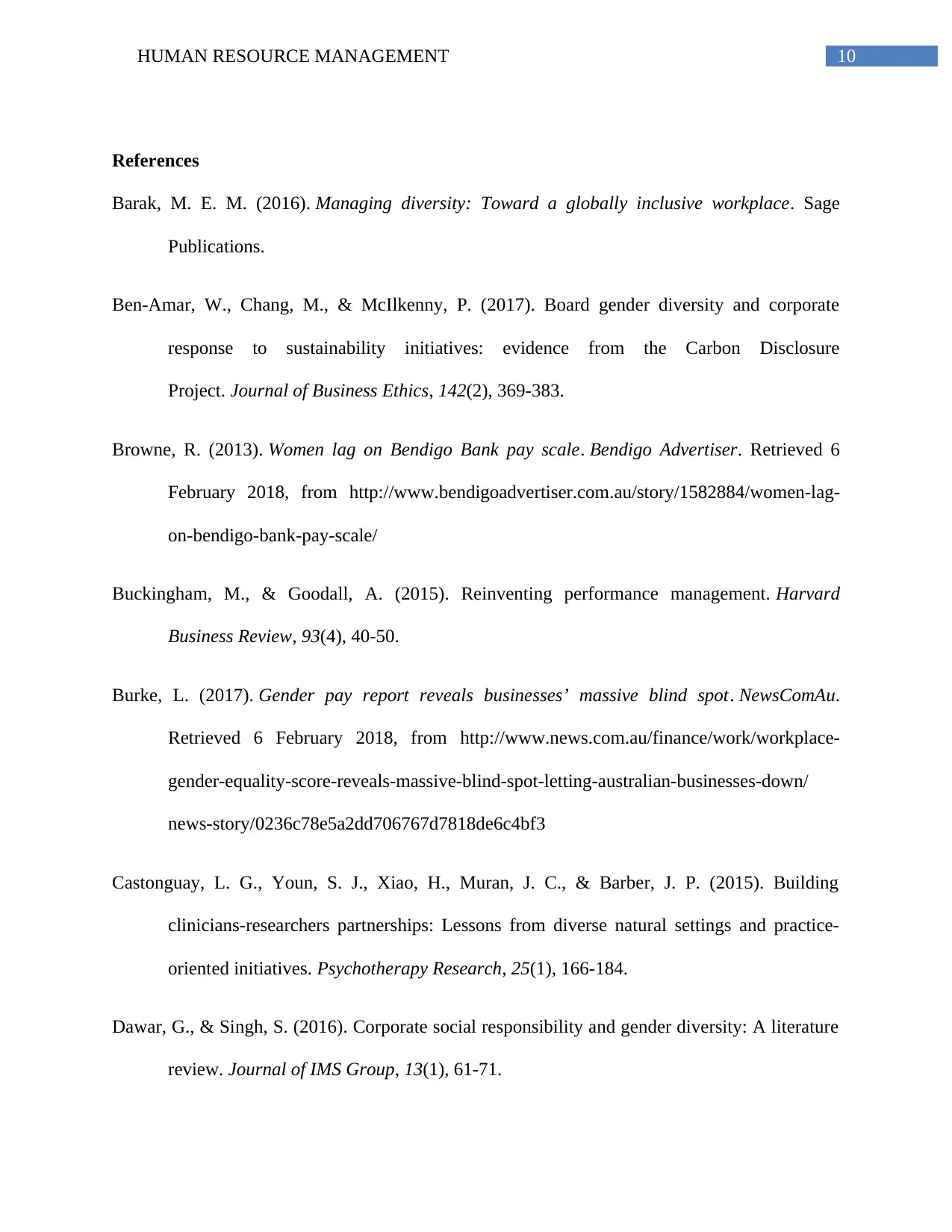
10HUMAN RESOURCE MANAGEMENT
References
Barak, M. E. M. (2016). Managing diversity: Toward a globally inclusive workplace. Sage
Publications.
Ben-Amar, W., Chang, M., & McIlkenny, P. (2017). Board gender diversity and corporate
response to sustainability initiatives: evidence from the Carbon Disclosure
Project. Journal of Business Ethics, 142(2), 369-383.
Browne, R. (2013). Women lag on Bendigo Bank pay scale. Bendigo Advertiser. Retrieved 6
February 2018, from http://www.bendigoadvertiser.com.au/story/1582884/women-lag-
on-bendigo-bank-pay-scale/
Buckingham, M., & Goodall, A. (2015). Reinventing performance management. Harvard
Business Review, 93(4), 40-50.
Burke, L. (2017). Gender pay report reveals businesses’ massive blind spot. NewsComAu.
Retrieved 6 February 2018, from http://www.news.com.au/finance/work/workplace-
gender-equality-score-reveals-massive-blind-spot-letting-australian-businesses-down/
news-story/0236c78e5a2dd706767d7818de6c4bf3
Castonguay, L. G., Youn, S. J., Xiao, H., Muran, J. C., & Barber, J. P. (2015). Building
clinicians-researchers partnerships: Lessons from diverse natural settings and practice-
oriented initiatives. Psychotherapy Research, 25(1), 166-184.
Dawar, G., & Singh, S. (2016). Corporate social responsibility and gender diversity: A literature
review. Journal of IMS Group, 13(1), 61-71.
References
Barak, M. E. M. (2016). Managing diversity: Toward a globally inclusive workplace. Sage
Publications.
Ben-Amar, W., Chang, M., & McIlkenny, P. (2017). Board gender diversity and corporate
response to sustainability initiatives: evidence from the Carbon Disclosure
Project. Journal of Business Ethics, 142(2), 369-383.
Browne, R. (2013). Women lag on Bendigo Bank pay scale. Bendigo Advertiser. Retrieved 6
February 2018, from http://www.bendigoadvertiser.com.au/story/1582884/women-lag-
on-bendigo-bank-pay-scale/
Buckingham, M., & Goodall, A. (2015). Reinventing performance management. Harvard
Business Review, 93(4), 40-50.
Burke, L. (2017). Gender pay report reveals businesses’ massive blind spot. NewsComAu.
Retrieved 6 February 2018, from http://www.news.com.au/finance/work/workplace-
gender-equality-score-reveals-massive-blind-spot-letting-australian-businesses-down/
news-story/0236c78e5a2dd706767d7818de6c4bf3
Castonguay, L. G., Youn, S. J., Xiao, H., Muran, J. C., & Barber, J. P. (2015). Building
clinicians-researchers partnerships: Lessons from diverse natural settings and practice-
oriented initiatives. Psychotherapy Research, 25(1), 166-184.
Dawar, G., & Singh, S. (2016). Corporate social responsibility and gender diversity: A literature
review. Journal of IMS Group, 13(1), 61-71.
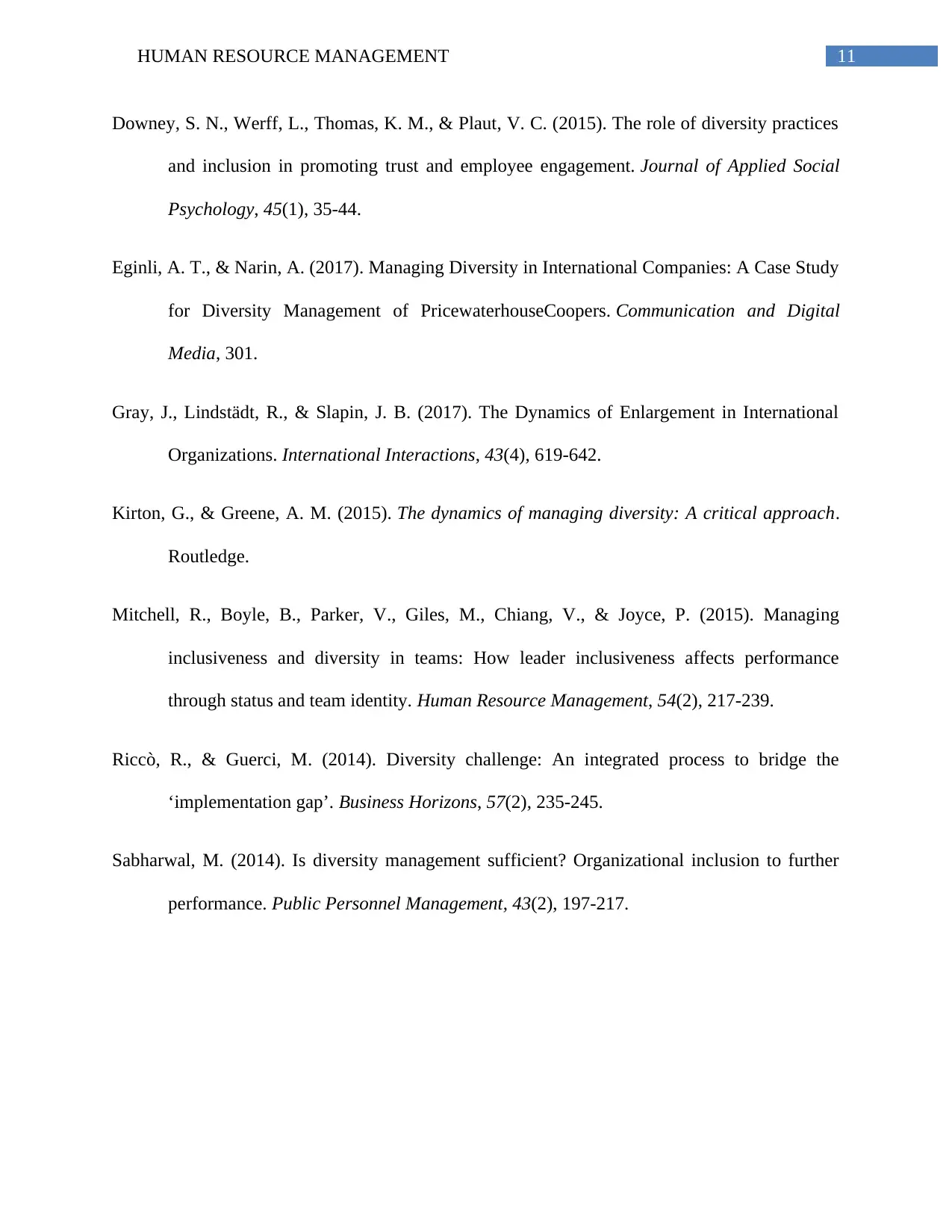
11HUMAN RESOURCE MANAGEMENT
Downey, S. N., Werff, L., Thomas, K. M., & Plaut, V. C. (2015). The role of diversity practices
and inclusion in promoting trust and employee engagement. Journal of Applied Social
Psychology, 45(1), 35-44.
Eginli, A. T., & Narin, A. (2017). Managing Diversity in International Companies: A Case Study
for Diversity Management of PricewaterhouseCoopers. Communication and Digital
Media, 301.
Gray, J., Lindstädt, R., & Slapin, J. B. (2017). The Dynamics of Enlargement in International
Organizations. International Interactions, 43(4), 619-642.
Kirton, G., & Greene, A. M. (2015). The dynamics of managing diversity: A critical approach.
Routledge.
Mitchell, R., Boyle, B., Parker, V., Giles, M., Chiang, V., & Joyce, P. (2015). Managing
inclusiveness and diversity in teams: How leader inclusiveness affects performance
through status and team identity. Human Resource Management, 54(2), 217-239.
Riccò, R., & Guerci, M. (2014). Diversity challenge: An integrated process to bridge the
‘implementation gap’. Business Horizons, 57(2), 235-245.
Sabharwal, M. (2014). Is diversity management sufficient? Organizational inclusion to further
performance. Public Personnel Management, 43(2), 197-217.
Downey, S. N., Werff, L., Thomas, K. M., & Plaut, V. C. (2015). The role of diversity practices
and inclusion in promoting trust and employee engagement. Journal of Applied Social
Psychology, 45(1), 35-44.
Eginli, A. T., & Narin, A. (2017). Managing Diversity in International Companies: A Case Study
for Diversity Management of PricewaterhouseCoopers. Communication and Digital
Media, 301.
Gray, J., Lindstädt, R., & Slapin, J. B. (2017). The Dynamics of Enlargement in International
Organizations. International Interactions, 43(4), 619-642.
Kirton, G., & Greene, A. M. (2015). The dynamics of managing diversity: A critical approach.
Routledge.
Mitchell, R., Boyle, B., Parker, V., Giles, M., Chiang, V., & Joyce, P. (2015). Managing
inclusiveness and diversity in teams: How leader inclusiveness affects performance
through status and team identity. Human Resource Management, 54(2), 217-239.
Riccò, R., & Guerci, M. (2014). Diversity challenge: An integrated process to bridge the
‘implementation gap’. Business Horizons, 57(2), 235-245.
Sabharwal, M. (2014). Is diversity management sufficient? Organizational inclusion to further
performance. Public Personnel Management, 43(2), 197-217.
⊘ This is a preview!⊘
Do you want full access?
Subscribe today to unlock all pages.

Trusted by 1+ million students worldwide
1 out of 12
Related Documents
Your All-in-One AI-Powered Toolkit for Academic Success.
+13062052269
info@desklib.com
Available 24*7 on WhatsApp / Email
![[object Object]](/_next/static/media/star-bottom.7253800d.svg)
Unlock your academic potential
Copyright © 2020–2025 A2Z Services. All Rights Reserved. Developed and managed by ZUCOL.




